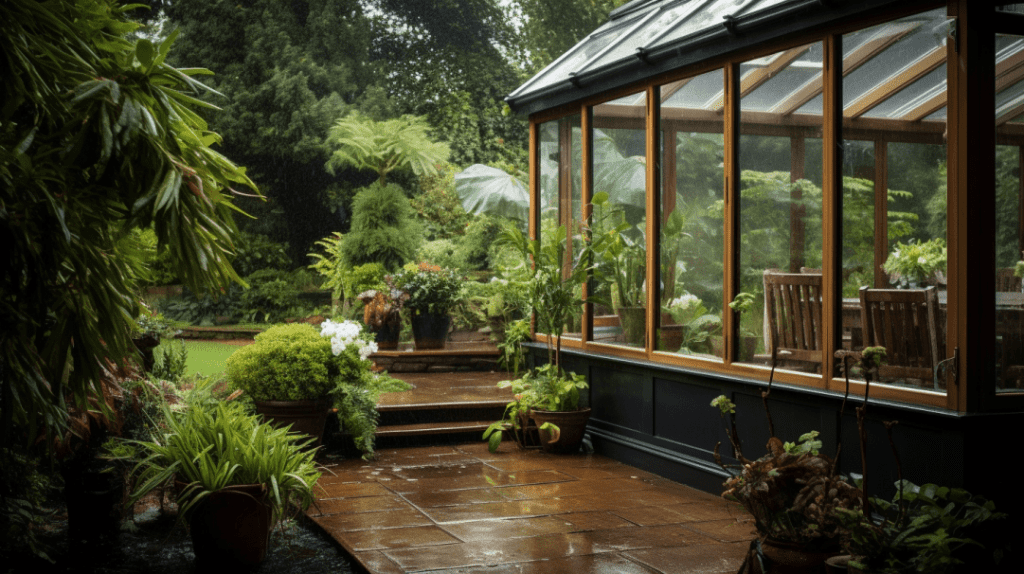If you’re a homeowner with a conservatory, you may be all too familiar with the dreaded problem of condensation. It’s not just an annoyance; it can lead to serious issues if left unaddressed. In our guide, we’ll discuss what causes condensation in a conservatory, the signs to watch out for, and the potential harm it can cause.
But fear not; there are solutions, and we won’t leave you stuck with the problem – we’ll also provide you with practical advice on how to avoid and manage conservatory condensation effectively.
What causes condensation in a conservatory?
Condensation occurs when warm, moist air comes into contact with cold surfaces, like the glass panels and windows in your conservatory. The air found inside of your conservatory may hold a certain amount of moisture, and when it becomes saturated, excess moisture turns into droplets on those cold surfaces. As conservatories contain a lot of glass and are often built completely airtight, they become a prime location for condensation to form.
Spotting the signs of bad condensation in a conservatory
Identifying where condensation is forming is the first step in addressing the issue. Have a look to see if you have spotted any of these signs in your conservatory:
Foggy Windows: If your conservatory windows frequently have a misty or foggy appearance, it’s likely due to condensation.
Dampness and Mould: Suffering from increased condensation can also lead to damp. You may notice damp patches on walls and ceilings, which can then result in mould growth. Mould can be very bad for your health and can produce allergens or even toxic substances. It is crucial to get damp checked and treated quickly before it causes long-term damage.
Musty Smells: If you notice a persistent musty or mouldy odour every time that you enter your conservatory, it is often a sign of high humidity caused by condensation.
How harmful can conservatory condensation be?
While condensation may initially seem like a minor pain, it can have significant consequences if left untreated. Over time, it can damage paintwork, furnishings and woodwork, leading to costly repairs or a conservatory roof replacement.
Untreated condensation can also encourage mould growth, which poses health risks to you and your family.
Aesthetically, condensation can obscure your view, make your windowsills fill with water, produce spots on the walls and cause black mould spores to form on window frames and doors. This can make your conservatory an unpleasant place to spend time.
How to avoid condensation in your conservatory
There are several ways to prevent or treat conservatory condensation, which is essential for maintaining a comfortable and damage-free space. Here are some steps you can take:
1. Increase ventilation
Regularly airing out your conservatory by opening windows and doors can help reduce humidity levels. It will promote natural ventilation and keep the moisture in the air to a lower level. However, this is not always possible during wetter periods or when you are away from home and can lead to heat being lost from the house.
2. Introduce air flow
Ceiling fans or air circulation systems can promote air movement, reducing the chances of condensation. You will want to look for one that works with the interior design of the conservatory and is practical in the space.
3. Avoid drying your laundry in your conservatory
A very common habit for people is to dry wet laundry in the conservatory. It can feel like the perfect spot outside of the main house. However, this releases additional moisture into the air, and without ventilation, this can then collect in the room.
4. Use a dehumidifier
A dehumidifier can effectively reduce excess moisture in the air, especially in the colder months. It stores the water in an internal tank that needs emptying. You can invest in two different types of dehumidifiers: desiccant and refrigerant.
- Desiccant dehumidifiers can work well in colder spaces, drawing moisture from the air regardless of room temperature.
- Refrigerant dehumidifiers need the room to be warmer than the cooler surfaces that are causing condensation.
5. Select house plants wisely
While houseplants are a lovely addition, some release moisture during transpiration, which can contribute to indoor humidity. However, there are several that help absorb moisture, such as palms, cacti, spider plants and types of ferns. It is helpful to do a little research before picking your plants.
Conservatory Condensation Advice
People can face a range of issues when dealing with conservatory condensation. Knowing how to tackle it can be tricky. Let’s address some of the most frequently asked questions:
Does putting the heating on get rid of condensation?
Heating your conservatory can help reduce the temperature differential between indoor and outdoor surfaces, which in turn may reduce the condensation that occurs. However, it’s not always the most energy-efficient solution, and there are other options that are more economical and offer a long-term solution.
Should I use a dehumidifier or heater in my conservatory?
Much like using house heating, both dehumidifiers and heaters can be effective in offering a short-term spot fix but offer little energy efficiency. Dehumidifiers are also usually better at directly reducing humidity levels in small areas that have a good airflow. Equally, they can often ruin the aesthetics of the room, taking up valuable space and looking bulky in situ.
What is the best way to insulate conservatory windows?
There are several options you can consider: investing in double-glazed or insulated glass panels to reduce heat transfer, and condensation is one of the main solutions recommended. There are also alternatives such as solar control film, trickle-vents, draught-proofing and installing blinds or curtains to minimise temperature change. It is worth checking whether the windows are the main cause of heat loss in the conservatory.
Where does most heat loss happen in a conservatory?
Although a proportion of heat is lost through the flooring, the greatest heat loss occurs through the roof. Having poor insulation can result in losing around 80% of the heat in the room. Many polycarbonate conservatory roofs offer little thermal efficiency and become cold in winter. Investing in effective insulation can help minimise this issue and provide an environment that keeps its warmth in colder weather and remains at a comfortable temperature in hotter periods.
How do you dry out a damp conservatory?
You can tackle drying out a damp conservatory by using good ventilation, dehumidifiers and heaters. However, this won’t help effectively prevent the recurring problem. Identifying what is causing the damp and getting it fixed will ensure you prevent any further damage from occurring.
Does condensation mean bad insulation?
Condensation usually indicates a problem with insulation; however, it can appear even in well-insulated conservatories. It is about managing humidity levels. Because condensation occurs when warm, moist air meets a cold surface, it is important to ensure your conservatory is insulated properly and uses materials that have a warmth retention system in effect. Minimising the cold surfaces will, in turn reduce the condensation present that can lead to long-term problems.
How can I improve my cold conservatory?
Proper insulation and managing condensation can make your conservatory more comfortable year-round. There is nothing welcoming about a cold conservatory. They can often become unused spaces in the winter, minimising your social and relaxation zones. Investing in solutions like insulated roof panels can bring back the warmth to your conservatory and return your comfortable living space.
Does conservatory roof insulation work?
In short, yes. Insulating your conservatory roof can significantly reduce heat loss and condensation issues. It can also provide one of the most energy-efficient options to do this. It is important to find a reliable provider who offers assurance and security. At Cosy Panels, they offer a 10-year guarantee that gives you peace of mind to know you will be investing in your long-term property improvement solution. The panels are lightweight and can be installed in just one day with no alteration to your existing structure.
If you’ve had enough of merely managing condensation and are looking to explore a long-term solution, it’s time to consider conservatory roof installation. You can visit CosyPanels for more information, read customer testimonies and view previous installations.
Ready to address your conservatory condensation irritation once and for all? Request a free quote today and enjoy a more comfortable and condensation-free conservatory.
Or to enquire by phone, get in touch on 0800 75 66 882.
Don’t let condensation cloud your conservatory experience any longer.


